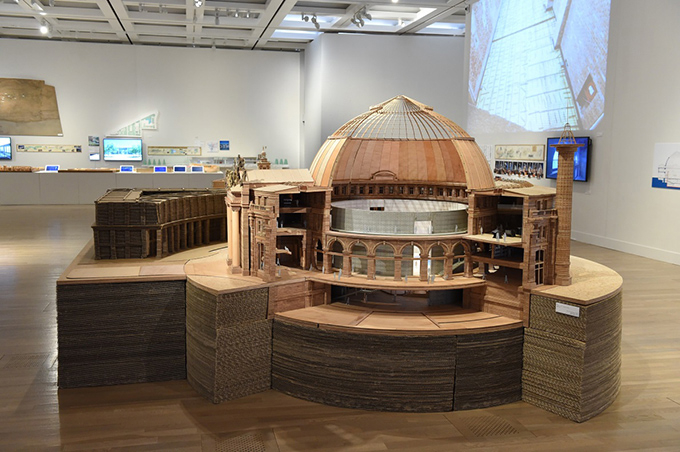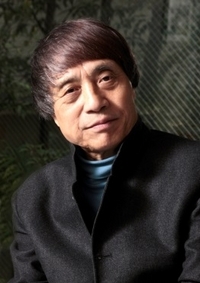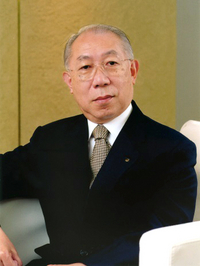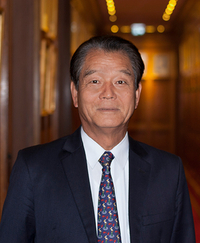
Japonismes 2018 (Vol. 1)
Tadao Ando

© Tadao Ando
From a Western perspective, Japan lies on the furthest cusp of the Far East, and Europeans were fascinated by this exotic and mysterious Eastern nation. In the Book of the Marvels of the World, Marco Polo describes Japan as "a land of gold," yet it seems the Western attraction to Japan was less motivated by material considerations, and more by its unique culture. Just what is "culture"? It could be defined as the energy that empowers life. The strength of culture lies in its ability to produce new values, thus adding richness and depth to life. In global society, financial power tends to be more tangible, but in the future, culture and tradition will likely prove to be far more powerful. The Japanese have always been exposed to a natural environment full of beauty, with a visible change in seasons that fostered a delicate sensibility. Art forms such as Kabuki, Bunraku, and ukiyo-e soon emerged, all of which were inexorably intertwined with the lives of the common people, eventually developing into a mass culture that is rarely found anywhere else in the world.
This unique Japanese aesthetic has had a profound effect on many artists in the West, including Monet and other Impressionists. Japan has also pioneered forms of written literature that are entirely unique. Haiku, represented by the master Matsuo Basho, is an example of the unique Japanese sensibility contained within three lines of five, seven, and five syllables, and expresses the beauty of the natural landscape and a profound depth of human sensibility. In France, these Japanese art forms roused much public interest, attracting the name japonisme. France, the mecca of art, also had great influence on Japanese artists. The cultural relationship between Japan and France has had a profound influence on the cultural development in both nations and endures to this day.
This year, in commemoration of the 160th anniversary of Japanese and French diplomatic relations, Japonismes 2018 will be held in Paris. The program includes an exhibition that begins in October at the Centre Pompidou, with displays about Naoshima Art Island and the Church of the Light in Ibaraki. The goal of the Naoshima project was not simply to create an art museum, but rather to install art that interacted with the natural surroundings, as well as to stimulate the region's economy. To reach Naoshima, a small island in the Seto Inland Sea, one must take a ferry from one of the main islands of the Japanese archipelago. When the project was first conceptualized in 1988, I was concerned that nobody would ever come to visit the island due to its inaccessibility. Now, the location is widely acclaimed as an "art island" and attracts over 400,000 visitors annually. For thirty years now, we have been developing the island and creating new pieces of architecture while remaining faithful to the original concept of maintaining the natural Setouchi scenery by building the architectural pieces to fit into their natural surroundings. As a result, all the projects on the island could only be created in their current locations. Naoshima Island allows people to step away from everyday life and really think about the meaning of life. With many lessons drawn from traditional Japanese aesthetics, which have developed in tandem with nature, the project is the fruition of the desire to create a place where architecture, artwork, and nature all come together. For the Church of the Light, I thought hard about light and shadow --a constant theme in traditional Japanese architecture. Light and shadow is the source of all life, and it occurred to me that I could draw on those concepts to create a place for the spirit to rest. Taking a simple box-shaped room of bare concrete and creating a cross-shaped opening for the light to enter, I was able to make the space transform as time progressed, changing its expression from moment to moment. The deep darkness adds brilliance to the cross of light when it shines. In the darkness, the light becomes a guide, drawing people to gather to pray. People come together seeking the light and use it to communicate with one another. It is a space with unshakeable power and a profound ephemeral quality. The exhibition will explore how the different pieces of architecture were developed and customized to their specific location, with reference to these particular examples.
My first exhibition in Paris was in 1982, at the IFA (Institut Français d'Architecture), and I am extremely honored to have the opportunity to exhibit again in the city, in this most commemorative year.
 Tadao Ando
Tadao Ando
Tadao Ando was born in Osaka in 1941. He is a self-taught architect and, in 1969, set up his own design studio, Tadao Ando Architects and Associates. His best-known buildings include the Church of the Light, the Modern Art Museum of Fort Worth, and the Punta della Dogana. His numerous awards include the Architectural Institute of Japan Award in 1979 for his Row House in Sumiyoshi, the Pritzker Architecture Prize in 1995, the Union Internationale des Architectes (UIA) Gold Medal in 2005, and the Japanese Order of Culture in 2010. Since 1997, he has worked as a Professor at the University of Tokyo, where he is currently Professor Emeritus. In 2000, he established the Setouchi Olive Fund to help restore damaged natural resources in the Seto Inland Sea region, and in 2011, became the chair of the Momo-Kaki Orphans Fund to aid those orphaned by the Great Tohoku Earthquake and Tsunami.
High Hopes for Japonismes 2018
Yoshiharu Fukuhara,
President, Amicale au Japon pour la Maison de la culture du Japon à Paris
There are an infinite number of ways to define culture, but I have come to think of it in the following way. Culture has been the fruit of human efforts since time immemorial to live better, and both the process and the product of the human creative endeavor to find a better life. People's lives are dictated by the natural environment and the climate of their homeland, and the unique culture of each nation is a result of the historical accumulation of this search for a better way of living. As living beings, culture is inherited from our forebears, and we do our best to expand on it, before passing it on to the next generation. If this cycle continues over time, a prosperous, competitive nation develops, with the ability to procure happiness for each of its citizens. The age when economic development takes precedence over human lives is now past us. Culture is a crucial element in the development of humanity. Every people and nation in the world recognizes the importance of culture, and we must think of designing a society wherein culture occupies a pivotal role. The nation most likely to understand this is France, the world's capital of culture. The cultural power of a certain place increases whenever it collides with the differing culture of another people or region, and this is evident in the case of France, whose culture has been honed through Islamic influences as well as those from Classical Europe, and which has also deftly assimilated the splendor of the Renaissance. In the 19th century, France began to absorb Far Eastern culture in the form of the japonisme movement, leading to the glory of Art Deco and Art Nouveau. The development of Japanese art and culture after the Meiji Reformation owes much to French culture, although by that time, elements of pre-modern Japanese culture such as ukiyo-e had already permeated French society. In this way, we see that cultural exchange was not simple, but a complex interaction between the two nations, much like a wave coming and going between the two shores. It is undoubtable that this most fortunate of relationships allowed both cultures to reach heights that would otherwise have been unobtainable.
Japonismes 2018 marks an attempt to create a new cultural movement with its nucleus in France, commemorating the 160th anniversary of Japanese-French diplomatic relations. With advances in transportation and communication, the world has rapidly become smaller. Japanese culture, which combines tradition and innovation, is making waves around the world. In this day and age, what kind of impact can contemporary Japan have on France, the heart of European culture? Whatever the answer may be, we can be sure that the impact will spread to the rest of Europe, before travelling even further abroad, eventually triggering further development in Japan. Japonismes 2018 is not about something happening on faraway shores--it is the first step in mapping out our future. I sincerely hope that the seeds sown now will allow beautiful flowers to blossom into the next generation.
 Yoshiharu Fukuhara
Yoshiharu Fukuhara
Born in 1931 in Tokyo. Graduated from the Faculty of Economics of Keio University in 1953 and joined Shiseido, where he served as President and CEO, then Chairman until 2001, when he was made Honorary Chairman. In addition to guiding the Shiseido brand toward global development, he was also active in promoting the firm's involvement in culture and the arts. He now occupies many public positions, including the Chair of the Characters Culture Promotion Organization, Honorary Director of the Tokyo Metropolitan Museum of Photography, and Honorary President of the Association for Corporate Support of the Arts. He has written several books including Kigyo wa bunka no patoron to narieru ka [Can Corporations be Patrons of the Arts?] (Kyuryudo), Mesena no ugoki mesena no kokoro [Corporate Artistic Sponsorship: The Practicalities and the Spirit] (Kyuryudo), and Bi [Beauty] (PHP Institute).
Japonismes 2018
Kiyoji Katakawa
Chairman, Association Amicale des Ressortissants Japonais en France
Chairman, Comite de Soutien aux Japonismes 2018
I first lived in Paris in 1978 while working for a trading company. I subsequently moved on to London and Hamburg but frequently returned to Paris on business, so I count this year as my 40th in the city. I consider myself extremely lucky that this anniversary coincides with the historical undertaking that is "Japonismes 2018: les âmes en resonance." I have always held a strong belief that Japanese culture affects the spirit, and that it cannot be understood in visual terms alone. I have been running Kinotayo (The Kinotayo Contemporary Japanese Cinema Festival) in Paris for 12 years and have discovered that if one identifies too much with the characters or becomes too deeply involved with the stories, it can lead to a sense of loss that bears witness to the emotions that have been ignited. For the exhibitions and cultural events taking place at over 20 venues in Paris, it will be important to secure emotional engagement with the audience. We need to use a variety of methods to convey information about the events and communicate their significance, ensuring that people have the prior knowledge necessary for each individual event to have its full intended impact. For this reason, at the board meeting of the Association Amicale des Ressortissants Japonais en France in January, we set up the Japonismes 2018 Support Committee, which I myself decided to chair. The committee gathers ideas of ways to ensure audience engagement, supporting the initiative's efforts to truly resonate with people's souls. As of February 2018, including both corporate and individual members, the committee involves a total 2,000 entities, or around 6,000 members. It is my hope that all our members will spread the news about Japonismes 2018, to engage their colleagues, neighbors, friends, and anyone else in France with whom they share their lives, and inspire as many people as possible to set foot inside the world of Japonisme. To this end, we will be featuring introductions to the events on our website, in our newsletter, and in our members' bulletin. Last year, more than 400 visitors participated in the Festival of Hope, an annual charity bazaar in May which we started in the wake of the Tohoku Earthquake and Tsunami, making it the ideal opportunity to publicize Japonismes 2018. We are planning to have a Japonismes 2018 booth, with printed happi coats and T-shirts to advertise the event as much as possible. We are also considering how to take advantage of the Association's 60 activities to further promote the event. I am ever so grateful to be able to contribute to this wonderful event, and I truly hope that we can engage as many people as possible, and that the event will boost French-Japanese relations.
Then, let's make most of this historical period of 8 months.
Paris, February 28, 2018
Kiyoji Katakawa
Born in Shizuoka Prefecture
Waseda University Tokyo
1992 ‒2009:
President of TOMEN France
CEO for urope, Middle East, and Africa of TOMEN Corporation
President, Funai Electric Co., Europe Ltd
President, Chambre de Commerce et d'Industrie Japonaise en France
Actually:
Chairman, Association Amicale des Ressortissants Japonais en France
Chairman, Festival of Japanese Contemporary Cinema Association Kinotayo
Chairman,Vin Passion Group & president of VP Wines France
Special advisor to president, Naked Inc.
Vice-president, French-Japanese Economic Exchange Committee
Keywords
Back Issues
- 2022.7.27 Beyond Disasters - T…
- 2022.6.20 Beyond Disasters - T…
- 2021.6. 7 Contributed Article …
- 2021.4.28 Crossing Borders, En…
- 2021.4.27 Contributed Article …
- 2021.4.20 Contributed Article …
- 2021.3.29 Contributed Article …
- 2020.12.22 Interview with the R…
- 2020.12.21 Interview with the R…
- 2020.11.13 Interview with the R…


